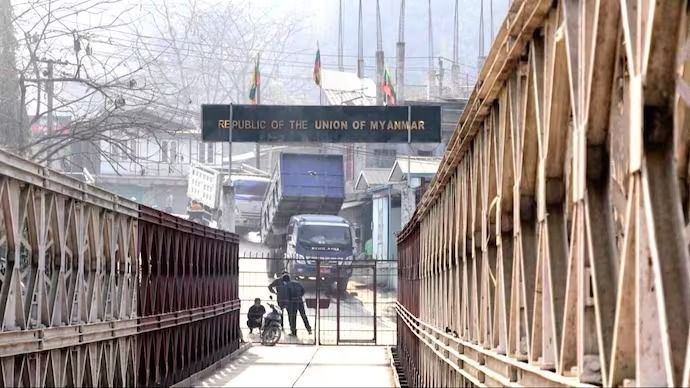In Feb 2021, Myanmar’s military leaders seized power ousting the elected government of Aung San Syu Kyi. Three years on, the resistance to the military rule continues. Ethnic Armed Organisations (EAOs) and People’s Defence Forces (PDF) control many towns across the country.
Indian Government has decided to fence the 1,643-km Indo-Myanmar border. It is reconsidering the Free Movement Regime (FMR) with Myanmar which allows tribes living along the border on either side visa-free travel upto 16 km inside the neighbouring country.
The Times of India citing sources indicated the Home Ministry has pitched for discontinuation of FMR – as it facilitates illegal immigration into the hill areas, and movement of insurgents as well as trafficking of narcotics and arms. The decision to fence the border comes after a long period of unrest in India’s north-eastern Manipur state.
India has advised its citizens against travel to Rakhine state and those who are there to leave the state immediately. Fierce fighting has been going on between the army and the rebel group Arakan Army which has captured government, military and other installations in border areas.
The capture of Paletwa town in Chin state on Myanmar’s western border is bad news for India as it could impact the Kaladan multi-modal transport project (KMTTP) designed to provide sea access to land-locked north-eastern India. The project has already faced significant delays. It involves inland water transport (IWT) from Myanmar’s Sittwe Port to Paletwa (158 KM), road of 110 KM to Indo-Myanmar border & further 100 KM to NH 54 (Lawngtlai).
The Arakan Army, along with the Myanmar Democratic Alliance Army and the Ta’ang National Liberation Army is part of the Three Brotherhood Alliance, which some claim has support from China. The alliance has pledged to protect Chinese investments and has gained strategic territory in North-East, the West and other parts of the country.
The Chinese presence along Myanmar’s coast in the Bay of Bengal has increased with a pipeline from Shwe gas fields near Kyaukpyu in Rakhine state to Yunan province in China. There are renewed efforts to construct Yunan-Mandalay-Kyaupkyu railway line as part of China-Myanmar Economic Corridor (CMEC).
The Hindu notes, “the successful completion of Kaladan not only requires competent technical personnel but also experts who can diligently monitor the fluid Chin-Arakan ethnic relations, the changing contours of military-EAO contestation, sectarian violence in the Rakhine state, and the growing Chinese footprint in Myanmar, particularly in the Rakhine state. The Kaladan experience suggests that perhaps it is time to bring such experts under one roof to expedite the implementation of various other connectivity and developmental assistance projects in India’s immediate neighbourhood.” It adds, “while security agencies will constantly evaluate the modalities of engaging with armed groups on India’s borders, there is a need to scale up humanitarian development assistance in coordination with a broader spectrum of ethnic organisations and local people to expedite Indian investment in the regions.”




